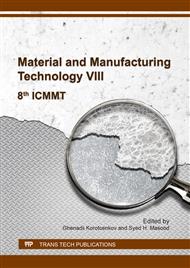[1]
G. Sandeep and G. Sonia, Pattern of Dental Malocclusion in Orthodontic Patients in Rwanda: a Retrospective Hospital Based Study, Rwanda Medical Journal, vol. 69, no. 4, p.13–18, (2012).
Google Scholar
[2]
M. K. Alam, A to Z Orthodontics: Removable Appliance, vol. 10. Kota Bharu: Universiti Sains Malaysia, (2012).
Google Scholar
[3]
Menteri Kesehatan Republik Indonesia, Keputusan Menteri Kesehatan Republik Indonesia no. 1415/MENKES/SK/X/2005 tentang Kebijakan Pelayanan Dokter Gigi Keluarga. Indonesia, (2005).
DOI: 10.24167/shk.v2i1.809
Google Scholar
[4]
M. F. Sfondrini, V. Cacciafesta, E. Maffia, S. Massironi, A. Scribante, G. Alberti, R. Biesuz, and C. Klersy, Chromium Release from New Stainless Steel, Recycled and Nickel-free Orthodontic Brackets, Angle Orthodontist, vol. 79, p.361–367, (2008).
DOI: 10.2319/042108-223.1
Google Scholar
[5]
S. Supriadi, T. W. Sitanggang, B. Irawan, B. Suharno, G. Kiswanto, and T. Prasetyadi, Orthodontics Bracket Fabrication Using the Investment Casting Process, International Journal of Technology, vol. 4, p.613–621, (2015).
DOI: 10.14716/ijtech.v6i4.1862
Google Scholar
[6]
L. Y. Min, K. A. Khalil, and H. Baryun, Rheological, Mechanical, and Corrosive Properties of Injection Molded 17-4 PH Stainless Steel, Transacstions of Nonferrous Metal Society of China, vol. 14, p.934–939, (2004).
Google Scholar
[7]
H. Ye, X. Y. Liu, and H. Hong, Sintering of 17-4 PH Stainless Steel Feedstock for Metal Injection Molding, Materials Letters, vol. 62, p.3334–3336, (2008).
DOI: 10.1016/j.matlet.2008.03.027
Google Scholar
[8]
H. -J. Sung, T. K. Ha, S. Ahn, and Y. W. Chang, Powder Injection Molding of a 17-4 PH Stainless Steel and the Effect of Sintering Temperature on Its Microstructure and Mechanical Properties, Journal of Materials Processing Technology, vol. 130–131, p.321–327, (2002).
DOI: 10.1016/s0924-0136(02)00739-2
Google Scholar
[9]
Y. Wu, R. M. German, D. Blaine, B. Marx, and C. Schlaefer, Effects of Residual Carbon Content on Sintering Shrinkage, Microstructure and Mechanical Properties of Injection Molded 17-4 PH Stainless Steel, Journal of Materials Science, vol. 7, p.3573–3583, (2002).
DOI: 10.1023/a:1016532418920
Google Scholar
[10]
C. Chang, P. Chen, and K. Hwang, Enhanced Mechanical Properties of Injection Molded 17-4PH Stainless Steel through Reduction of Silica Particles by Graphite Additions, Materials Transactions, vol. 51, no. 12, p.2243–2250, (2010).
DOI: 10.2320/matertrans.m2010209
Google Scholar
[11]
A. Szewczyk-Nykiel, M. Hebda, M. Nykiel, T. Pieczonka, and J. Kazior, Influence of Sintering Atmosphere on Densification Development of 17-4 PH Stainless Steel Powder, in Euro PM2012 Congress and Exhibition, 2012, p.1–7.
DOI: 10.1179/1743290112y.0000000015
Google Scholar
[12]
S. Supriadi and E. R. Baek, Sintering of Stainless Steel Nanopowders for Micro-Component Part Applications, Applied Mechanics and Materials, vol. 493, p.697–702, (2014).
DOI: 10.4028/www.scientific.net/amm.493.697
Google Scholar
[13]
A. Islam, H. N. Hansen, N. M. Esteves, and T. T. Rasmussen, Effects of Holding Pressure and Process Temperatures on the Mechanical Properties of Moulded Metallic Parts, in Annual Technical Conference (ANTEC 2013, 2013, vol. 1, p.483–487.
Google Scholar
[14]
W. Fang, X. B. He, R. J. Zhang, S. Di Yang, and X. H. Qu, Evolution of Stresses in Metal Injection Molding Parts during Sintering, Transactions of Nonferrous Metals Society of China, vol. 25, p.552–558, (2015).
DOI: 10.1016/s1003-6326(15)63637-8
Google Scholar
[15]
K. T. Oh, S. U. Choo, K. M. Kim, and K. N. Kim, A Stainless Steel Bracket for Orthodontic Application, European Journal of Orthodontics, vol. 27, no. 3, p.237–244, (2005).
DOI: 10.1093/ejo/cji005
Google Scholar


